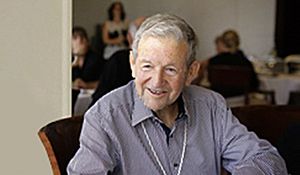Yoram Tsafrir facts for kids
Quick facts for kids
Yoram Tsafrir
|
|
|---|---|
 |
|
| Born | 30 January 1938 Kfar Azar, Israel
|
| Died | 23 November 2015 (aged 77) |
| Alma mater | Hebrew University of Jerusalem |
| Scientific career | |
| Institutions |
|
Yoram Tsafrir (born January 30, 1938 – died November 23, 2015) was an Israeli archaeologist. An archaeologist studies old human history by digging up sites. Professor Tsafrir taught at the Hebrew University of Jerusalem. He was also a member of the Israel Academy of Sciences and Humanities.
His work focused on the ancient land of Palestine. He studied the Byzantine period and its effect on old synagogues. He also looked at how many people lived in Palestine during that time. His research included ancient mosaics and important dig sites. These sites included Beit She'an and Rehoboth in the Negev desert.
Contents
About Yoram Tsafrir
Yoram Tsafrir was born in 1938 in Kfar Azar, Israel. He studied at the Hebrew University of Jerusalem. He graduated in 1976 and became a professor there. He taught archaeology until he retired in 2006.
From 1989 to 1992, he led the Institute of Archaeology. He also directed the Jewish National and University Library from 2001 to 2007. He was a visiting scholar at Harvard University and Dumbarton Oaks in Washington, D.C. Yoram Tsafrir passed away in Jerusalem in 2015.
Exploring Ancient History
Professor Tsafrir's main work was in the archaeology and history of Palestine. He studied different time periods. These included the Hellenistic, Roman, Byzantine, and early Islamic times.
He led many important archaeological digs. Some of these sites were Bet She'an-Scythopolis and Rehoboth in the Negev. He also worked at Alexandreion (Sartaba) and Horvat Berachot. Horvat Berachot is located between Bethlehem and Hebron.
Discoveries and Ideas
Yoram Tsafrir believed that by the year 400 C.E., Christians were the main group in Palestine. He also found that very few synagogue buildings in Palestine were built in the second and early third centuries.
In Jerusalem, he worked on many old structures. These included the Acra Fortress and the Nea Ekklesia of the Theotokos church. From 1974, he helped update the Holyland Model of Jerusalem. This model shows what Jerusalem looked like long ago. He took over this project from his teacher, Michael Avi-Yonah.
He wrote several books and articles. With Yitzhak Magen, he published a book about their digs at Sartaba/Alexandrium Fortress. In 1993, he published Ancient Churches Revealed. He also helped create maps and guides for the Roman and Byzantine periods in Israel. His work also looked at how cities changed over time.
The Holyland Model of Jerusalem
The Holyland Model of Jerusalem is a special model of the city. It shows Jerusalem exactly as it was before the Romans destroyed it in 70 AD. This amazing model helps people see what the ancient city looked like.
The Holyland Hotel in Jerusalem supported the creation of this model in 1964. Michael Avi-Yonah built it between 1964 and 1974. Yoram Tsafrir later improved and added to the model.
The model was built using real stone from Jerusalem. It also has colorful small ceramic tiles. The Temple and palaces in the model are decorated with gold leaf. The model is built to a scale of 1:50. This means every 1 unit on the model is 50 units in real life. Professor Tsafrir also created guides and pamphlets to explain the model.
Published Works
- Tsafrir, Y.; Leah Di Segni; Judith Green (1994). (TIR): Tabula Imperii Romani. Iudaea, Palestina: Eretz Israel in the Hellenistic , Roman and Byzantine Periods; Maps and Gazetteer. Jerusalem: Israel Academy of Sciences and Humanities. ISBN 965-208-107-8. https://books.google.com/books?id=8XJtAAAAMAAJ.

